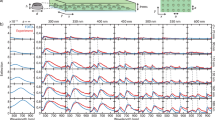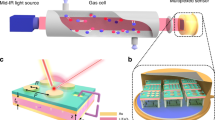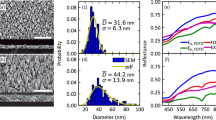Abstract
Metallic nanostructures possess plasmonic resonances that spatially confine light on the nanometre scale. In the ultimate limit of a single nanostructure, the electromagnetic field can be strongly concentrated in a volume of only a few hundred nm3 or less. This optical nanofocus is ideal for plasmonic sensing. Any object that is brought into this single spot will influence the optical nanostructure resonance with its dielectric properties. Here, we demonstrate antenna-enhanced hydrogen sensing at the single-particle level. We place a single palladium nanoparticle near the tip region of a gold nanoantenna and detect the changing optical properties of the system on hydrogen exposure by dark-field microscopy. Our method avoids any inhomogeneous broadening and statistical effects that would occur in sensors based on nanoparticle ensembles. Our concept paves the road towards the observation of single catalytic processes in nanoreactors and biosensing on the single-molecule level.
This is a preview of subscription content, access via your institution
Access options
Subscribe to this journal
Receive 12 print issues and online access
$259.00 per year
only $21.58 per issue
Buy this article
- Purchase on Springer Link
- Instant access to full article PDF
Prices may be subject to local taxes which are calculated during checkout






Similar content being viewed by others
References
Schuller, J. A. et al. Plasmonics for extreme light concentration and manipulation. Nature Mater. 9, 193–204 (2010).
Stockman, M. I. Nanofocusing of optical energy in tapered plasmonic waveguides. Phys. Rev. Lett. 93, 137404 (2004).
Ropers, C. et al. Grating-coupling of surface plasmons onto metallic tips: A nanoconfined light source. Nano Lett. 7, 2784–2788 (2007).
Stockman, M. I., Faleev, S.V. & Bergman, D. J. Localization versus delocalization of surface plasmons in nanosystems: Can one state have both characteristics? Phys. Rev. Lett. 87, 167401 (2001).
Alu, A. & Engheta, N. Tuning the scattering response of optical nanoantennas with nanocircuit loads. Nature Photon. 2, 307–310 (2008).
Shvets, G., Trendafilov, S., Pendry, J. B. & Sarychev, A. Guiding, focusing, and sensing on the subwavelength scale using metallic wire arrays. Phys. Rev. Lett. 99, 053903 (2007).
Becker, J. et al. Plasmonic focusing reduces ensemble linewidth of silver-coated gold nanorods. Nano Lett. 8, 1719–1723 (2008).
Lal, S., Link, S. & Halas, N. J. Nano-optics from sensing to waveguiding. Nature Photon. 1, 641–648 (2007).
Anker, J. N. et al. Biosensing with plasmonic nanosensors. Nature Mater. 7, 442–453 (2008).
Liao, H. W., Nehl, C. L. & Hafner, J. H. Biomedical applications of plasmon resonant metal nanoparticles. Nanomedicine 1, 201–208 (2006).
Wang, F. & Shen, Y. R. General properties of local plasmons in metal nanostructures. Phys. Rev. Lett. 97, 206806 (2006).
Maier, S. A. Plasmonics: Fundamentals and Applications (Springer, 2007).
Durach, M., Rusina, A. & Stockman, M. I. Toward full spatiotemporal control on the nanoscale. Nano Lett. 7, 3145–3149 (2007).
Kinkhabwala, A. et al. Large single-molecule fluorescence enhancements produced by a bowtie nanoantenna. Nature Photon. 3, 654–657 (2009).
Anger, P., Bharadwaj, P. & Novotny, L. Enhancement and quenching of single-molecule fluorescence. Phys. Rev. Lett. 96, 113002 (2006).
Kuhn, S., Hakanson, U., Rogobete, L. & Sandoghdar, V. Enhancement of single-molecule fluorescence using a gold nanoparticle as an optical nanoantenna. Phys. Rev. Lett. 97, 017402 (2006).
Li, J. F. et al. Shell-isolated nanoparticle-enhanced Raman spectroscopy. Nature 464, 392–395 (2010).
Camden, J.P. et al. Probing the structure of single-molecule surface-enhanced Raman scattering hot spots. J. Am. Chem. Soc. 130, 12616–12617 (2008).
Lim, D. K., Jeon, K. S., Kim, H. M., Nam, J. M. & Suh, Y. D. Nanogap-engineerable Raman-active nanodumbbells for single-molecule detection. Nature Mater. 9, 60–67 (2010).
Taminiau, T. H., Stefani, F. D., Segerink, F. B. & Van Hulst, N. F. Optical antennas direct single-molecule emission. Nature Photon. 2, 234–237 (2008).
Bharadwaj, P., Beams, R. & Novotny, L. Nanoscale spectroscopy with optical antennas. Chem. Sci. 2, 136–140 (2011).
Schumacher, Th. et al. Nanoantenna-enhanced ultrafast nonlinear spectroscopy of a single gold nanoparticle. Preprint at arXiv:1104.4855 (2011).
Sondergaard, T. et al. Extraordinary optical transmission enhanced by nanofocusing. Nano Lett. 10, 3123–3128 (2010).
Chen, C. J. & Osgood, R. M. Direct observation of the local-field-enhanced surface photochemical-reactions. Phys. Rev. Lett. 50, 1705–1708 (1983).
Zhang, W. H., Huang, L. N., Santschi, C. & Martin, O. J. F. Trapping and sensing 10 nm metal nanoparticles using plasmonic dipole antennas. Nano Lett. 10, 1006–1011 (2010).
Aimovi, S. S., Kreuzer, M. P., González, M. U. & Quidant, R. Plasmon near-field coupling in metal dimers as a step toward single-molecule sensing. ACS Nano 3, 1231–1237 (2009).
Adato, R. et al. Ultra-sensitive vibrational spectroscopy of protein monolayers with plasmonic nanoantenna arrays. Proc. Natl Acad. Sci. 106, 19227–19232 (2009).
Hao, F., Nordlander, P., Sonnefraud, Y., Van Dorpe, P. & Maier, S. A. Tunability of subradiant dipolar and Fano-type plasmon resonances in metallic ring/disk cavities: Implications for nanoscale optical sensing. ACS Nano 3, 643–652 (2009).
Khalavka, Y., Becker, J. & Sonnichsen, C. Synthesis of rod-shaped gold nanorattles with improved plasmon sensitivity and catalytic activity. J. Am. Chem. Soc. 131, 1871–1875 (2009).
Reinhard, B. M., Sheikholeslami, S., Mastroianni, A., Alivisatos, A. P. & Liphardt, J. Use of plasmon coupling to reveal the dynamics of DNA bending and cleavage by single EcoRV restriction enzymes. Proc. Natl Acad. Sci. 104, 2667–2672 (2007).
Novo, C., Funston, A. M. & Mulvaney, P. Direct observation of chemical reactions on single gold nanocrystals using surface plasmon spectroscopy. Nature Nanotech. 3, 598–602 (2008).
Aksu, S. et al. High-throughput nanofabrication of infrared plasmonic nanoantenna arrays for vibrational nanospectroscopy. Nano Lett. 10, 2511–2518 (2010).
Bingham, J. M., Anker, J. N., Kreno, L. E. & Van Duyne, R. P. Gas sensing with high-resolution localized surface plasmon resonance spectroscopy. J. Am. Chem. Soc. 132, 17358–17359 (2010).
Kreno, L. E., Hupp, J. T. & Van Duyne, R. P. Metal–organic framework thin film for enhanced localized surface plasmon resonance gas sensing. Anal. Chem. 82, 8042–8046 (2010).
Lewis, F. A. The Palladium Hydrogen System (Academic Press, 1967).
Vargas, W. E., Rojas, I., Azofeifa, D. E. & Clark, N. Optical and electrical properties of hydrided palladium thin films studied by an inversion approach from transmittance measurements. Thin Solid Films 496, 189–196 (2006).
Favier, F., Walter, E. C., Zach, M. P., Benter, T. & Penner, R. M. Hydrogen sensors and switches from electrodeposited palladium mesowire arrays. Science 293, 2227–2231 (2001).
Walter, E. C., Favier, F. & Penner, R. M. Palladium mesowire arrays for fast hydrogen sensors and hydrogen-actuated switches. Anal. Chem. 74, 1546–1553 (2002).
Chadwick, B., Tann, J., Brungs, M. & Gal, M. A hydrogen sensor based on the optical generation of surface plasmons in a palladium alloy. Sensors Actuators B 17, 215–220 (1994).
Zeng, X. Q. et al. Hydrogen gas sensing with networks of ultrasmall palladium nanowires formed on filtration membranes. Nano Lett. 11, 262–268 (2010).
Zoric, I., Larsson, E. M., Kasemo, B. & Langhammer, C. Localized surface plasmons shed light on nanoscale metal hydrides. Adv. Mater. 22, 4628–4633 (2010).
Bhuvana, T. & Kulkarni, G. U. A SERS-activated nanocrystalline Pd substrate and its nanopatterning leading to biochip fabrication. Small 4, 670–676 (2008).
Johnson, J. L., Behnam, A., Pearton, S. J. & Ural, A. Hydrogen sensing using Pd-functionalized multi-layer graphene nanoribbon networks. Adv. Mater. 22, 4877–4880 (2010).
Yang, F., Kung, S. C., Cheng, M., Hemminger, J. C. & Penner, R. M. Smaller is faster and more sensitive: The effect of wire size on the detection of hydrogen by single palladium nanowires. ACS Nano 4, 5233–5244 (2010).
Langhammer, C., Yuan, Z., Zoric, I. & Kasemo, B. Plasmonic properties of supported Pt and Pd nanostructures. Nano Lett. 6, 833–838 (2006).
Langhammer, C., Zoric, I. & Kasemo, B. Hydrogen storage in Pd nanodisks characterized with a novel nanoplasmonic sensing scheme. Nano Lett. 7, 3122–3127 (2007).
Pakizeh, T., Langhammer, C., Zoric, I., Apell, P. & Kall, M. Intrinsic Fano interference of localized plasmons in Pd nanoparticles. Nano Lett. 9, 882–886 (2009).
Larsson, E. M., Langhammer, C., Zoric, I. & Kasemo, B. Nanoplasmonic probes of catalytic reactions. Science 326, 1091–1094 (2009).
Langhammer, C., Larsson, E. M., Kasemo, B. & Zoric, I. Indirect nanoplasmonic sensing: Ultrasensitive experimental platform for nanomaterials science and optical nanocalorimetry. Nano Lett. 10, 3529–3538 (2010).
Langhammer, C., Zhdanov, V. P., Zoric, I. & Kasemo, B. Size-dependent kinetics of hydriding and dehydriding of Pd nanoparticles. Phys. Rev. Lett. 104, 135502 (2010).
Abdelsalam, M. E., Mahajan, S., Bartlett, P. N., Baumberg, J. J. & Russell, A. E. SERS at structured palladium and platinum surfaces. J. Am. Chem. Soc. 129, 7399–7406 (2007).
Wu, D. Y., Li, J. F., Ren, B. & Tian, Z. Q. Electrochemical surface-enhanced raman spectroscopy of nanostructures. Chem. Soc. Rev. 37, 1025–1041 (2008).
Roy, R., Hohng, S. C. & Ha, T. A practical guide to single-molecule FRET. Nature Methods 5, 507–516 (2008).
Liu, N. et al. Three-dimensional photonic metamaterials at optical frequencies. Nature Mater. 7, 31–37 (2008).
Tian, Z. Q., Ren, B. & Wu, D. Y. Surface-enhanced Raman scattering: From noble to transition metals and from rough surfaces to ordered nanostructures. J. Phys. Chem. B 106, 9463–9483 (2002).
Langhammer, C., Zhdanov, V. P., Zoric, I. & Kasemo, B. Size-dependent hysteresis in the formation and decomposition of hydride in metal nanoparticles. Chem. Phys. Lett. 488, 62–66 (2010).
Sachs, C. et al. Solubility of hydrogen in single-sized palladium clusters. Phys. Rev. B 64, 075408 (2001).
Hughes, R. C. & Schubert, W. K. Thin-films of Pd/Ni alloys for detection of high hydrogen concentrations. J. Appl. Phys. 71, 542–544 (1992).
Trapp, O. et al. High-throughput kinetic study of hydrogenation over palladium nanoparticles: Combination of reaction and analysis. Chem. Eur. J. 14, 4657–4666 (2008).
Acknowledgements
We would like to thank X. Meng for help with the metal deposition at the Microlab Facility of the Electrical Engineering and Computer Science Department, University of California, Berkeley. The SEM studies were supported by the Molecular Foundry at the National Center for Electron Microscopy at Lawrence Berkeley National Laboratory. The experimental set-up was funded by the grant “A Synergistic Approach to the Development of New Classes of Hydrogen Storage Materials” from the US Department of Energy, DE-AC03-76SF00098. We acknowledge S. Hein for his material visualizations. We thank Th. Schumacher and M. Lippitz for discussions and comments. We thank A. Tittl and N. Strohfeldt for help with the measurements and data analysis. N.L., M.L.T. and A.P.A. acknowledge financial support through the Plasmonic-Enhanced Catalysis Project of the Air Force Office of Science Research, award number FA9550-10-1-0504. M.H. and H.G. were financially supported by Deutsche Forschungsgemeinschaft (SPP1391 and FOR557), by BMBF (13N9048 and 13N10146) and by Landesstiftung BW.
Author information
Authors and Affiliations
Contributions
All authors contributed extensively to the work presented in this paper.
Corresponding author
Ethics declarations
Competing interests
The authors declare no competing financial interests.
Rights and permissions
About this article
Cite this article
Liu, N., Tang, M., Hentschel, M. et al. Nanoantenna-enhanced gas sensing in a single tailored nanofocus. Nature Mater 10, 631–636 (2011). https://doi.org/10.1038/nmat3029
Received:
Accepted:
Published:
Issue Date:
DOI: https://doi.org/10.1038/nmat3029
This article is cited by
-
High-performance hydrogen gas sensor system based on transparent coaxial cylinder capacitive electrodes and a volumetric analysis technique
Scientific Reports (2024)
-
Recent advances of economically synthesised polymers/composites consisting of graphene and silver nanoparticles to achieve sustainable existence
Polymer Bulletin (2024)
-
On-chip ultrasensitive and rapid hydrogen sensing based on plasmon-induced hot electron–molecule interaction
Light: Science & Applications (2023)
-
Tuning the surface morphologies of ZnO nanofilms for enhanced sensitivity and selectivity of CO2 gas sensor
Applied Physics A (2023)
-
Well-defined nanostructuring with designable anodic aluminum oxide template
Nature Communications (2022)



